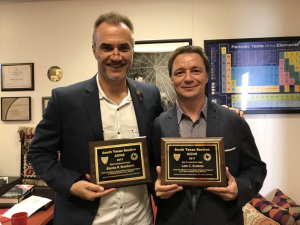Cullen College engineering professors collaborate to solve monolayer catalyst mystery
The South Texas Section (STS) of the American Institute of Chemical Engineers (AIChE) chose a paper written by two UH Cullen College of Engineering professors and their Ph.D. students for its Best Fundamental Paper Award.
The award was presented Tuesday at the monthly STS-AIChE meeting in Galveston.
The paper, titled “Finite Size Effects in Submonolayer Catalysts Investigated by CO Electrosorption on PtsML/Pd(100),” was published in the Journal of The American Chemical Society in 2017. It was based on research conducted by Stanko Brankovic, professor of electrical and computer engineering, and his student Quiyi Yuan, along with Lars Grabow, associate professor of chemical and biomolecular engineering, and his student Hieu Doan.
The team’s project solved a fundamental research question related to the catalysis that occurs in fuel cells. The best catalytic material for use in chemical fuel cells are all based on platinum (Pt) – a rather expensive material. There has been a drive for the last 15 to 20 years to minimize the amount of Pt used and reduce costs.
However, reducing the amount of Pt used changes the fundamental catalytic activity.
“The most Pt efficient geometry is a single layer of atoms, a monolayer, on the surface of a cheaper host material. But when the mismatch between the atom distances is too large then you don’t form a perfectly flat continuous monolayer of Pt atoms,” Grabow said. “Instead, the atoms form small islands with breaks in between. This change in geometry gives rise to a new component of strain, which depends on the size of the Pt islands.”
Brankovic and Yuan measured carbon monoxide absorption in Pt monolayers on Palladium (Pd) single crystal surfaces. Grabow and his student Doan ran computer simulations to explain experimental data and identify structures that could obtain favorable catalytic properties due to the finite size effect. Using theoretical calculations to test their hypothesis, Grabow and Doan confirmed that the finite size effect is the origin of the observed Pt catalyst monolayer activity.
“Stanko and I got together and we were able to explain the breakdown of the prevailing theory for monolayer catalysts. The impact of that finding is rather large,” said Grabow, adding that the information can help future development in catalyst monolayer synthesis. “That justifies why it was selected as the best fundamental paper.”
Brankovic agreed and added more. “The best part of the paper, besides uncovering fundamental science, is the synergy between theory and experiment,” he said. “It is an example of a fruitful scientific and collegial collaboration between two groups at UH.”
Both Brankovic and Grabow are winners of prestigious National Science Foundation CAREER Awards, which partially funded this research. Additional funding came in the form of a University of Houston GEAR Award, which offers seed funding to young researchers looking to get projects inside their laboratory off the ground.
Yuan and Doan, who were both Ph.D. students at the time of research, have graduated from UH and are pursuing successful careers as researchers in industry and national labs.
“AIChE is the largest chemical engineering society in the world,” Grabow said. “It really feels good that the Society recognizes the value of the fundamental contributions that we’re making.”
This is a second award for the Doan and Grabow team. They both coauthored a paper that won STS best fundamental paper award in 2014.
AIChE has more than 60,000 members from more than 110 countries. Through its varied programs, AIChE provides a focal point for information exchange regarding cutting-edge chemical engineering research in such areas as nanotechnology, sustainability, hydrogen fuels, biological and environmental engineering, and chemical plant safety and security. More information about AIChE is available at www.aiche.org.
